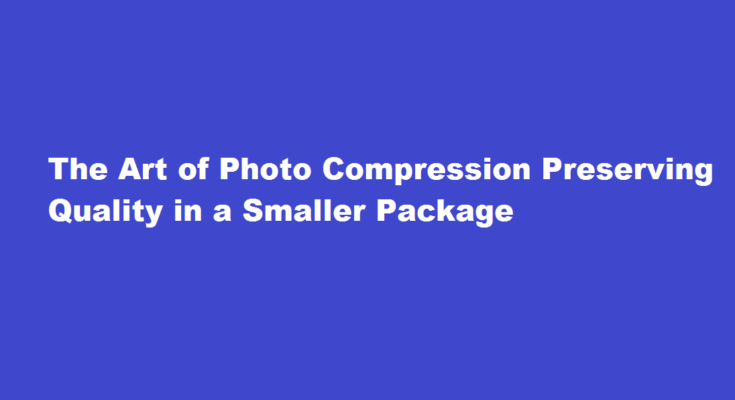Introduction
In this digital age, where high-resolution images dominate online platforms and mobile devices, photo compression plays a vital role in optimizing storage space and facilitating efficient image sharing. By reducing the file size without sacrificing quality, photo compression ensures faster uploads, smoother web browsing, and easier transmission. In this article, we will explore the process of compressing photos while maintaining their visual integrity, offering useful tips and techniques for achieving optimal results.
Understanding Photo Compression
Photo compression is the process of reducing the file size of an image by utilizing various algorithms and techniques. It eliminates unnecessary data while preserving the essential visual elements. There are two types of photo compression: lossless and lossy. Lossless compression retains all the original data, ensuring no quality loss but with a smaller file size. Lossy compression, on the other hand, achieves higher compression ratios by discarding some less noticeable image details, leading to a slight reduction in quality.
Choosing the Right File Format
Before compressing a photo, it is essential to select the appropriate file format. The most commonly used formats for compressed images are JPEG, PNG, and WebP. JPEG is excellent for photographs and complex images, as it offers a good balance between quality and file size. PNG is ideal for graphics, logos, and images with transparency, as it provides lossless compression. WebP is a newer format that combines the advantages of JPEG and PNG, offering superior compression for web images. Consider the specific requirements of your image to determine the most suitable format.
Utilizing Image Editing Software
Image editing software such as Adobe Photoshop, GIMP, or online tools like Squoosh can be valuable resources for compressing photos. These tools provide a range of compression options, allowing you to balance quality and file size. Start by resizing the image to the desired dimensions, keeping in mind the target platform. Then, experiment with different compression levels or quality settings. While reducing the quality setting too much can result in noticeable artifacts, a slight adjustment can significantly reduce the file size without compromising visual appeal. Additionally, consider removing unnecessary metadata, such as EXIF data, to further reduce the file size.
Optimizing Compression for Web
When compressing images for web use, it is crucial to find the optimal balance between quality and loading speed. Start by resizing the image to match the intended display size on your website or social media platform. This step alone can significantly reduce the file size. Next, apply an appropriate compression method, such as lossy compression with a medium quality setting. Online tools like Kraken.io, TinyPNG, or JPEGmini specifically cater to web image optimization, automatically finding the best settings for your images.
Consider Progressive Image Loading
Progressive image loading is a technique that improves the user experience by displaying a low-quality version of the image first, which gradually becomes clearer as the full resolution is loaded. This method not only reduces the perceived loading time but also allows for more aggressive compression without compromising the visual experience. By using progressive image loading, you can strike a balance between quick loading times and maintaining image quality.
FREQUENTLY ASKED QUESTIONS
Why should you compress photos?
By reducing the file size, more images can be stored in a given amount of disk or memory space. The image also requires less bandwidth when being transmitted over the internet or downloaded from a webpage, reducing network congestion and speeding up content delivery.
Why do we need to compress?
Compressed files require significantly less storage capacity than uncompressed files, meaning a significant decrease in expenses for storage. A compressed file also requires less time for transfer while consuming less network bandwidth. This can also help with costs, and also increases productivity.
What is called compression?
Compression is a region in a longitudinal wave where the particles are closest together. A rarefaction is a region in a longitudinal wave where the particles are furthest apart. The region where the medium is compressed is known as compression and the region where the medium is spread out is known as a rarefaction.
Conclusion
In the world of digital imagery, photo compression is a valuable skill to master. By understanding the fundamentals of compression, selecting the appropriate file format, and utilizing image editing software, you can effectively reduce file sizes without significant loss in quality. Whether you are preparing images for web use or optimizing storage space, following the techniques discussed in this article will ensure your compressed photos remain visually appealing while being easy to share and store.
Read Also : The Ultimate Guide to Video Compression Maximizing Quality and Minimizing File Size



